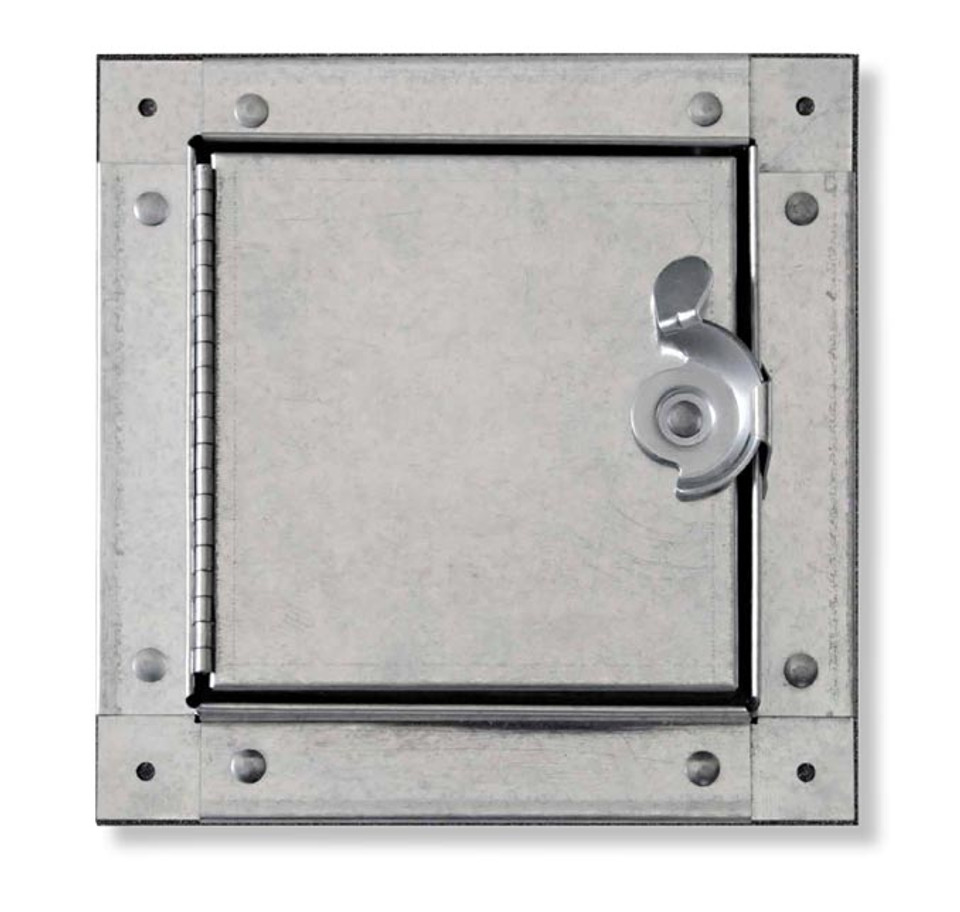

Clogged ducts, air leaks, and uneven airflow can all significantly impact an HVAC system’s efficiency. These problems can lead to uncomfortable indoor temperatures, higher energy bills, and premature equipment failure.
A simple but often overlooked solution is to install duct access doors. They can dramatically improve airflow efficiency and overall HVAC performance when chosen and installed correctly. This blog post will explore their types, benefits, and factors when selecting one.
What Are Duct Access Doors?
Duct access doors provide entry points for inspecting, maintaining, and cleaning ductwork. They are designed for easy opening and secure closing, allowing technicians to access the interior of air ducts without compromising the system’s performance.
7 Main Types of Duct Access Doors
Manufacturers offer several types of duct access doors to meet varied HVAC needs. Each of these access doors and panels offers unique features and benefits. Let us explore the main types and their typical uses in residential, commercial, and industrial buildings:
1. Self-Stick Duct Panels
Self-stick duct panels, like the HDSS-6020 duct access door, have strong adhesive backing. This design makes the installation straightforward, eliminating the need for additional tools and hardware. These access doors and panels provide quick and convenient access to sheet metal ducts.
2. High-Pressure Duct Access Doors
Demanding HVAC environments with extreme pressure require a more robust solution. High-pressure duct access doors are typically galvanized or stainless steel and can withstand significant pressure differentials. They are ideal for commercial and industrial HVAC systems where maintaining system pressure is critical.
3. Fiberglass Duct Access Doors
Despite being made from galvanized steel or aluminum, these access doors and panels are compatible with fiberglass ducts. They often feature insulated door panels and reliable sealing to maintain duct efficiency.
4. Grease Duct Access Doors
Commercial kitchens face strict ventilation safety regulations. Grease duct access doors meet these demanding standards. They feature materials resistant to high temperatures and tight seals that prevent grease and smoke leakage. These doors comply with strict fire codes for commercial kitchen ventilation systems.
5. Hinged Duct Access Doors
Routine inspections demand frequent panel removal. Hinged duct access doors offer a convenient alternative. They are available in various sizes and materials to suit different duct types. These solutions are also useful in areas where frequent inspections or maintenance are required.
6. Round Duct Access Doors
Circular ductwork presents unique maintenance challenges. Round duct access doors provide the perfect fit. They come in various diameters to match different duct sizes and are often used in industrial and commercial HVAC systems with circular duct configurations.
7. Walk-Through Duct Access Doors
These access doors are large enough to allow full-body entry into expansive ductwork. They are essential for maintaining large-scale HVAC systems in commercial and industrial settings.
How Do Duct Access Doors Enhance Airflow Efficiency?
Facilitating Maintenance and Cleaning
Regular cleaning is important for removing debris, dust, and contaminants that can accumulate over time, restricting airflow and reducing system efficiency. With duct access doors, it is easy to access the interior of the ducts to inspect for any issues and perform thorough cleaning.
This ease of maintenance ensures air can flow freely through the system, improving overall performance and reducing energy consumption.
Reducing Air Leaks
Air leaks in ductwork can lead to significant energy loss and reduced airflow efficiency. Duct access doors prevent air leaks by providing a secure seal around the access point.
When installed correctly, they create a tight fit with the ductwork, preventing air from escaping and improving the HVAC system’s overall efficiency. This creates a more comfortable indoor space and lowers energy bills.
Improving Airflow Balance
Duct access doors can also help to improve airflow balance throughout the HVAC system. They provide easy duct access, allowing users to adjust dampers and make changes to distribute air evenly throughout the building. This balanced airflow eliminates hot or cold spots, optimizing system performance.
Factors to Consider When Choosing Duct Access Doors
Size and Shape
Selecting the right size and shape of duct access doors is important to ensure compatibility with the ductwork. The access doors should be large enough to provide easy access for maintenance and cleaning but not so large that they compromise the structural integrity of the ductwork.
They should also match the shape of the duct openings to ensure a proper fit and prevent air leaks.
Material
The material used for duct access doors is another important factor to consider. Common materials include galvanized steel, stainless steel, and aluminum. Each material has its advantages and disadvantages:
- Galvanized Steel: Durable and affordable, galvanized steel is a popular choice for duct access doors. However, it can rust when exposed to moisture, so it’s best used in drier locations.
- Stainless Steel: Stainless steel’s impressive corrosion resistance ensures long-lasting durability. It is often used in environments with high humidity or exposure to corrosive substances.
- Aluminum: This material is lightweight and corrosion-resistant, making it ideal for duct access doors in areas with limited space or where weight is a concern. However, it may not be as durable as steel.
Installation Location
The location of duct access doors is important for ensuring easy accessibility for maintenance and cleaning. Doors should be placed strategically, allowing technicians to reach and inspect different ductwork sections.
Aesthetics
The appearance of duct access doors is also a factor to consider. Choosing models that complement the overall aesthetic of the building can help to create a more cohesive and visually appealing environment. Consider their color, finish, and overall design to ensure they blend well with the surrounding materials and décor.
Conclusion
Duct access doors offer numerous benefits for improving airflow efficiency and HVAC performance. They facilitate maintenance, reduce air leaks, and improve airflow balance, enhancing the system’s effectiveness.
When choosing duct access doors, it is important to consider their size, shape, material, and installation location. Doing so leads to improved indoor comfort, reduced energy use, and lower maintenance costs.
- 0shares
- Facebook0
- Pinterest0
- Twitter0
- Reddit0













